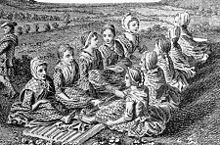Walking
Fulling is the deformation of materials through mechanical processing such as kneading, pressing or pulling. It is used as a deliberate manufacturing process for fabrics . In rubber tires, it causes energy losses in the power transmission as a result of heating.
Word origin
The word itself comes etymologically from Old High German walchan , kneading, from Old Norse valka , dragging around. Walking with the feet in cloth production was also known in medieval England. A Walker was on English and walker , which also accounts for the identical and similar-sounding surname Welker , Welcker developed. In English, this developed the meaning of to walk , to “walk ” with the feet.
Leather processing
Fulling in leather processing is a work process in which wet leather is stretched over a model in order to bring it into a certain shape. Such a model is for example the last of the shoemaker or the plaster model of the orthopedic mechanic for orthotics or prostheses . You need fulling nails or bags , a small hammer and fulling pliers .
To stretch the leather, the nails are driven in at small intervals so that the leather is tightly stretched around the model. In addition, careful fixation prevents the holding pins from being torn out of the model. The leather contracts a little while it dries and becomes tense and would lose its shape as a result. If the leather is dry after milling, it will keep its shape. The nails are removed and the leather cut and sewn.
Cloth and felt manufacture
When finished fabrics are fulled, so-called fulled fabrics are created by the felting of the fibers in the fabric . This process was Walk since the High Middle Ages in fulling mills performed. The material is hit with hammers under running water.
The more original method of fulling unwoven wool fibers is to wrap the felt in cloths and knead it while rolling. This method is still used today by Central Asian steppe peoples , where large rolls of felt are dragged around by horses.
metallurgy
Milling in metallurgy is the repeated bending of sheet metal over rollers in order to make them malleable for further processing.
Vehicle tires
Tires , in particular those made of rubber , such as solid rubber or pneumatic tires, are deformed in their cross-section when moving under load in the area of the contact surface . In the further course of the rolling process, the cross-section normalizes again. The material is milled and heated by the resulting frictional heat. The work done is called flexing .
The force required for rolling the tire is the largest component of the rolling resistance , acts against the driving force of the vehicle and thus increases its energy consumption . Furthermore, the resulting heating of the tire can reduce the aging resistance , fatigue strength and also the (long or short-term possible) maximum speed.
An increase in the air pressure in the pneumatic tire, the choice of a rubber compound with less internal friction in the frequency range of the excitation or suitable constructive measures reduce the flexing and thus the flexing work.
